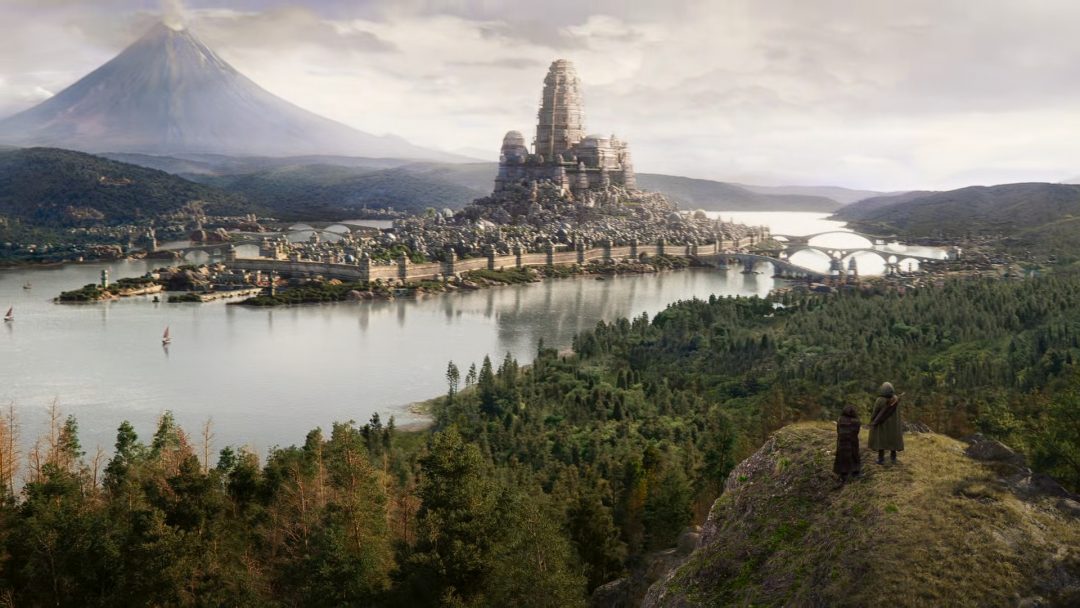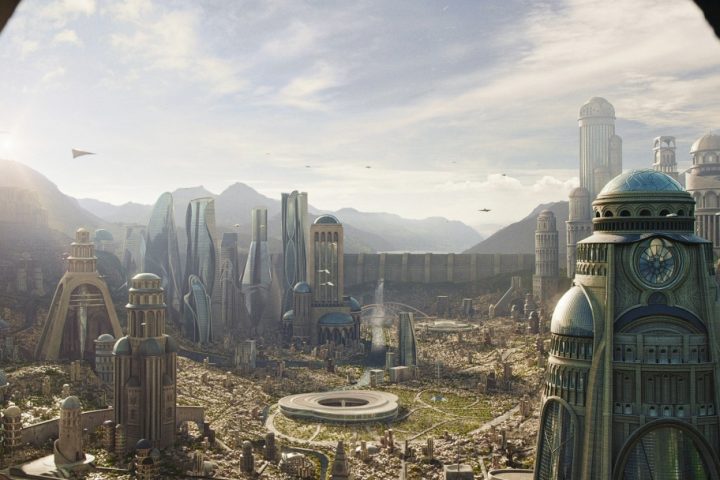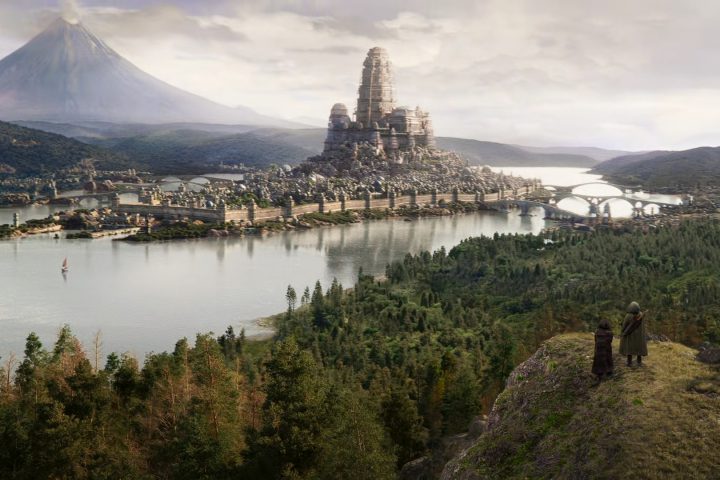The following post I originally wrote for another blog called Devouring Books. I had always intended to post it here as well, but then forgot about it. Until now, though I am expanding and improving on the post here so even if you happen to have read it already I encourage you to read it anyway.
Setting the stage
I want to take this opportunity to talk about something you come across in just about every fantasy story, the city. Some stories are set entirely within one city, but even ones that start with your typical farm boy or girl will inevitably have that hero visit a city at one point or another. But when you set out to create a city for your story or tabletop campaign, there’s a lot you could consider to flesh it out and make it memorable.
In fantasy the world can be a strange place. For example, my short story World Eater takes place within the mostly dead remains of a titanic eldritch god drifting in the void between realities. In such a place assumptions like gravity and sunlight aren’t a given and that represents its own challenges for how people manage to survive. This, in turn, will influence what settlements would look like and if they would even be possible. But for the rest of this post, I will assume a more or less spherical world with a roughly earth-like environment.
There are several problems that a settlement needs to solve for it to function and not become unlivable. How does the city feed itself, where does it get its water, what does it use as a fuel source, and what to do with all the waste so many people living together generate? None of these sound exciting, most readers or players won’t ask that question when they come across this city in your story or campaign, but answering them helps you paint the picture in your own mind and if your story takes you to a new part of the city, you already have some ideas of what the characters will find.
The first condition
So let’s start with the most important question, the second one. People need water, even when they don’t drink it directly because it’s not safe. They need water for cooking, washing, and to prepare most of the alcoholic beverages they might be drinking instead of water. Easiest answer is a river and indeed we see that many historical cities had a river running through them or besides them. Rome, Paris, London, Amsterdam, Berlin, Budapest, Vienna, Constantinople, Alexandria, just to name some well known ones.
With a river running through the city, there also needs to be a way to cross it. Most likely ferries or a bridge, depending on how wide the river is and what the people in your setting can build. But a river does more than hydrate a city and take away its waste, it is also the most important way commerce flows in and out of the city as transporting goods over land get very expensive very quickly. That means docks, warehouses, sailors, and the bars they frequent.
And if it’s not a river or a lake that meets the city’s needs, than something else is going on. Perhaps an underground spring, aqueducts, or a stable portal to the elemental plane of Water. All of these have their implications for your city’s place in the world and what’s going on in it. The underground spring might be considered holy, many cultures like the Romans and the Celts did so and archaeologists still find the offerings they left behind today. Aqueducts imply this city was planned or improved by a larger empire with the resources to spend on such a project and a good reason to do so. And having one stable interdimensional portal in your world naturally leads to what other portals are about and what comes through them?
You are what you eat
But although staying hydrated is important, a city won’t survive long without food. Now if there is a river, than fish will likely be part of the diet. But the river contributes more through irrigation of the farms that will surround your city.
The fantasy cities we see on the screen always seem to be surrounded by empty grassland. From Minas Tirith and Edoras to King’s Landing and Cintra, all of them appear to have nothing beyond their walls. Real cities in history weren’t like that.
Unless they are conjuring all of their food through magic, your city will be surrounded by farms and gardens with fields for grazing further away. Those fields are further away because the livestock can transport itself to the city when needed. Now chances are that the people working those fields don’t actually live in the city but in communities surrounding the city. This leads to the question what the city’s relationship is with these communities on which it relies to feed itself? Is it a cooperative relationship or one of exploitation?
There is also the question of what else besides food these communities offer and what they receive from the city in return. Do they have a promise of protection from the city, are they allowed to shelter behind its walls in the event of an attack, or are they the main source of manpower for their army?
Before mass conscriptions many societies required their soldiers to bring their own equipment and that usually meant you had to have a certain amount of land to generate the wealth necessary to buy that equipment.
Fueling the fire
Fuel is the third consideration and is one regardless of climate. In a hot climate, people won’t need a fire to stay warm, but they will need it to cook, to work metal, and fire clay to name some examples. In such a climate the city might grind to a stand still during the hottest part of the day and people might opt to sleep on their flat roofs to escape the heat. Which means that your hero stalking across rooftops could find themselves with a lot of company at night. Or maybe your city lacks streets altogether, like Çatalhöyük from around 6000 BCE. This was one of the oldest cities we’ve found and all the buildings were built right next to each other with all traffic happening along its roofs. The inhabitants even constructed communal ovens on their roofs later on.
In a colder climate people will need fuel to stay warm and most likely this fuel will be wood. That wood has to come from somewhere and we’ve already established that your city will be surrounded by farmland. But anywhere they can’t grow crops, like the sides of the roads, on the boundaries between fields, that’s where you’ll see trees. Those trees may be coppiced to promote the production of enough wood.

So your city should have smell woodsmoke wherever they go, unless another fuel source is used. Peat and coal are some historical examples, but so is natural gas. From as far back as the Han dynasty they would drill for natural gas in certain regions which would then be transported through bamboo pipes. No magic required.
And speaking of fire, consider how the people of this city deal with fires that have gone out of control. For example, in ancient Rome before Augustus there were only privately funded fire brigades. Rome’s richest man, Marcus Crassus, supposedly formed a fire brigade of slaves who would only put out the fire after the owner had sold the building to Crassus. And you can imagine that the value dropped as the fire consumed more and more.
The city of Edo went for a more organized response on the other hand, with samurai firefighters. Initially only for the Shogun’s residence but the system evolved over time as Japanese society and the political clout of people grew. I’m very much oversimplifying this and I encourage you to read further about this. It is quite the fascinating history.
Output
I already mentioned it earlier, but all this activity also produces waste. There is of course human waste, both liquid and solid, which might be gotten rid of through sewers though that requires significant engineering knowledge and beyond building the system it also needs to be maintained. This is why old sewers are so big, they needed to be so people could move through them to inspect and repair them.
I won’t go too deep into how you can use sewers for your story or campaign, there are numerous examples in not only books, movies, games, and recorded DnD campaigns to give plenty of inspiration for that. I do want to point out that a sewer does not necessarily need to cover the entire community. Indeed, which parts do and do not get access to the sewers tells your reader something about that society.
However, even without sewers waste still needs be gotten rid off and just chucking it out the window is not considered acceptable even in medieval society. In that case, a pit might be used or someone comes along on the regular to take it away. Those people could be paid by the community, or they might be selling it as urine, for example, was often used in the tanning process.
But that’s not the only waste produced as there’s plenty of others waste. Scraps of food as not everything can be eaten like bones or peels. But things break too and while people will try to reuse or recycle as much as they can, it’s not always possible. Once again using ancient Rome as an example, the Romans produced so much potshards that it created an artificial hill that still exists today. It’s called Monte Testaccio and consists almost entirely out of the shards of amphora used to transport olive oil.
What came before
This brings me to the final consideration I will address in this post, one that doesn’t concern the functioning of the city as such. What is the history of your city? Again, you don’t need a detailed timeline but knowing why the city started in this place and what trajectory the city is on right now helps you get a feel for the city’s atmosphere.
Was the city planned from its founding or did it grow over the centuries? In case of the former, I expect a lot of straight lines. If the former, than the streets will be old winding country roads petrified and preserved by the expanding city. Though perhaps a great fire or other disaster has destroyed the old city and it has recently been rebuild wiping much of those traces away.
And how has the city been doing these past decades? Has a growing economy attracted a lot of immigration or has a recent plague left many houses empty? To come back to Constantinople, it’s population declined over the centuries so that by the fifteenth century there was enough space for farms inside the Theodosian walls.
But it might also be that the city has grown beyond its current confines with entire neighborhoods outside its official boundaries. These people might be necessary to keep the city’s economy growing but as they don’t live inside the ‘real’ city they might still be treated as outsiders even if they have lived their for years or even a generation. And if they live outside the city, how many of the city’s laws apply?
Darshehem
To conclude this blog post I want to quickly create a city, taking the above considerations in account. I present to you the city of Darshehem.
Sprawled up the foothills of the Gray Mountains lies the city of steel. Two streams fed by melting snow from the mountains meet in Dashehem and divide it into three parts. The Crown between the streams, and then the Smoking Quarters north of the river El Barai and New Town curving along the south banks of the river. El Barai in turn feeds the terraced fields and orchards of date palms below the city before flowing out into the plains beyond.
But it is not only water that flows from the mountains, iron and coal too are mined from them and taken to the city where craftsmen turn them into steel and give the city its grimy coat while a growing mountain of ash squats above the Smoking Quarters. Darshehem steel is desired and so it has been some centuries since the city was its own master. However, lately there have been problems. The iron has become of poor quality, rumors fly that it rots like old wood now.
And yet the queen still expects Darshehem to pay its taxes and she grows impatient with their excuses. Something must be done.
With that I will end today’s blog post. Please let me know what you think of it in the comments.





[…] my recent post about worldbuilding advice based on historical examples I came across some news archeological news […]